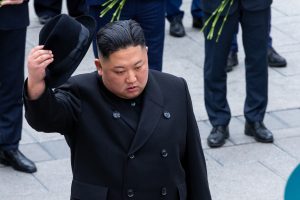For those interested in what is happening in North Korean, it can be easy to be swayed by “information” communicated by South Korean government agencies and media. For instance, after the daughter of North Korean leader Kim Jong Un entered the limelight in November 2022, there were a flurry of unconfirmed reports that she is his second child, Kim Ju Ae.
If that is true, and Kim’s oldest child is a boy and the favorite candidate to succeed his father, then why is that child’s name not circulating, even as a rumor? From the outset, there have been many questions, such as why Kim’s supposed third child was not made public at the same time, if the second child and daughter was announced with the aim of keeping his oldest offspring a secret. Although it has never been verified, the claim that Kim Jong Un has three children has been widely accepted as established fact. Yet even the name “Ju Ae” lacks evidence.
Although father and daughter stood side by side at a military parade in February 2023 and the title “respected daughter” was used, skepticism that she was Kim’s successor remained strong in South Korea. The South Korean National Intelligence Service provided its analysis to the South Korea National Assembly Intelligence Committee, in which it concluded that Kim frequently had his daughter accompany him to official events “most likely to create the impression of fourth generation hereditary succession,” dismissing the view that she is his successor.
However, it was only toward the end of 2023 that the South Korean government started communicating any in-depth views. A typical example is when the director of the National Intelligence Service stated, “We’re presently seeking to determine if she really is the successor.”
The minister of unification also said that she is “a strong candidate for the fourth generation of hereditary power succession to lead the system.” Nonetheless, he also suggested that “[Kim’s] system has become less stable, so having her appear early and indicating an intention toward her succession had the aim of bolstering internal unity.” That is a statement that must be read in the context of South Korean politics, given that it is a longstanding policy of conservative governments in Seoul to claim that North Korea is weak and should be absorbed to achieve unification of the Korean peninsula.
For as long as North Korea remains a personal dictatorship, there is always a possibility of a sharp policy shift with every change in the thinking of its leadership. Moreover, in the absence of any conclusive evidence presented about the Kim family, outside observers must acknowledge the possibility that they have overlooked critical information. Consequently, we must be circumspect in our assertions.
Still, there is circumstantial evidence for identifying Kim’s daughter as his successor. According to the memoirs of former South Korean President Moon Jae-in, which were published in in May, Kim apparently said in 2018, “I have a daughter, and I don’t want my daughter’s generation to live with the burden of nukes,” as a way to explain his intention to denuclearize. The fact that Kim only referred to his “daughter,” rather than to his “child” or “son,” suggests that he does not have a male child, or that if he does, he does not want to present him as his successor.
At the start of August this year, Kim delivered a speech in which he asserted, “The United States we are facing is not just an administration that comes and goes after a few years, but a hostile nation that our children and grandchildren will be dealing for generations to come.” This statement carries with it the assumption that the North Korean system will live on indefinitely.
Kim’s daughter also appeared at this event, her first appearance in 80 days. Interestingly, Kim’s sister, Kim Yo Jong, was reportedly escorting her niece, showing deference. There was a time when South Korea was touting Kim Yo Jong herself as successor, but that possibility has now all but vanished.
The North Korean media have mentioned Kim’s daughter more than 20 times, but has yet to explain the background to her appearance. Moreover, the way in which she is covered is inconsistent, suggesting that the authorities are still experimenting with how best to promote her.
In January, when the Rodong Sinmun reported on the activities of Kim senior, it frequently inserted the sentence “accompanied by his respected daughter.” This style of introducing the daughter on her own seemed to add some degree of clarity to the succession issue, but the paper soon reverted to its previous approach, with the wording “respected daughter” disappearing from use after a couple of months.
However, when Kim attended an event in March, reports included several photos of father and daughter, and the words “the great leaders” were used. This was the first time this plural appellation had appeared, and it strongly implies that the daughter is on a par with Kim Jong Un, suggesting that she is indeed his successor.
Yet if you were to ask those with close ties to Pyongyang about this, not only would they lack any reliable information about the Kim family, it would be taboo for them to even discuss it. Speculation masquerading as information will likely continue to emerge from South Korea, but those seeking real insight will need to continue to carefully focus on the tone adopted by North Korean media.

































